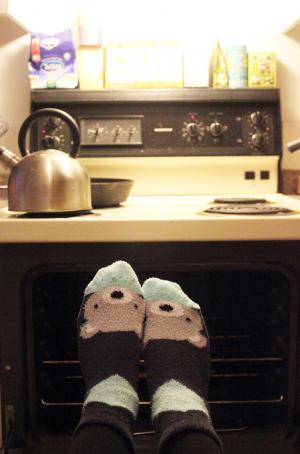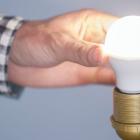Heating homes efficiently
Submitted by Emily Brown on | Updated Sat, 17/09/2016 - 23:49

With the first substantial snowfall in Montreal last week and temperatures dropping below zero, you might have cranked up the heating at home. In 2009, Canadians spent $26.8 billion on household energy needs, and almost two thirds of this energy was used for space heating. Nearly half of Canadian households used natural gas as their main heating fuel in 2007, emitting not only warmth but also greenhouse gases. Whether it be natural gas, electricity, wood, heating oil or propane, there are a number of ways to prepare your home for winter and to reduce your energy needs. Take a look at these ten handy tips on how to efficiently heat your home and effectively help save both the planet and your pennies (or cents).
1. Install and set a programmable thermostat
If your Montreal apartment is fitted with dated thermostat dials whose faded numbers are barely visible, it might be a good idea to check that these are working correctly or better still upgrade them. Using a programmable thermostat can save you an estimated 10% per year on heating costs. Setting the temperature to 12°C at night and 15°C during the day will keep you energy efficient. If these numbers seem low, why not challenge yourself to gradually decrease the temperature on your thermostat by a degree or two at a time, making sure to stop of course before you burst your water pipes and develop hypothermia – this isn’t that kind of challenge.
2. Inspect heating systems regularly
Opening up your windows during the summer of construction in Montreal might have let in more than just a cool breeze. Dirt, soot or corrosion can stop your heating systems from working efficiently. To prevent increased energy costs and potential damage to your equipment, inspect, clean or replace air filters regularly. Check air ducts and heating pipes to make sure they are properly sealed. Ensure that radiators, baseboard heaters and warm-air registers are not blocked by unnecessary items that prevent air from flowing freely. Additional, annual maintenance work can be arranged with a qualified technician.
3. Install proper insulation
Although increasing wall insulation is probably not the simplest job, it will make a huge difference to your energy bill. Use resources such as the Canada Mortgage and Housing Corporation website to find out more about the insulation you need. Cold and mouldy walls are signs of insulation problems. To check how well insulated your roof is, take a look outside next time it snows - if the heat escaping from your home is melting away the winter wonderland, it’s time to insulate. Eco-friendly insulation can take the form of old jeans or sheep’s wool. Although purchasing sheep might increase the amount of body heat emitted at home, sheep’s wool insulation can be sourced elsewhere.
4. Eliminate drafts
While you’re up in the attic installing that insulation, perhaps you’ll come across a box of forgotten possessions from the ‘90s, such as incense and an inexplicable number of candles. On a windy day, use these to trace your windowsills, doors and vents – the goal here is not so much to ward away evil energy-spending spirits but to locate drafts with the flickering of the flame or smoke trail. Once identified, these air leaks can be sealed with silicone caulking, foam sealant or rubber weather sealing strips. Hanging heavy curtains in front of unused doors and using draft stoppers, which could be your next crafting project or simply a rolled-up towel, will also help keep the cold air out. Outlet or socket sealers work well for electrical outlets and switches, another source of drafts.
5. Insulate windows
Weatherise your windows by covering them with window insulation film, which can be purchased from a hardware store or online. Make sure to choose window treatments that don’t stop the sun from naturally warming your home with its penetrating rays. Heavy curtains will add an extra barrier to the cold, but opening these up on south and west facing windows during the day will allow the sun to do its work. Insulated window blinds can also be used to insulate while still letting in light, and some apparently resemble the covering of a Nasa spaceship.
5. Install ceiling fans
I know what you’re thinking, ceiling fans are a thing of the ‘80s that were designed for keeping you cool, temperature-wise. You might also be surprised to learn that most, if not all, ceiling fans have a reverse setting for winter, which allows the hot air that has risen to your ceiling to be drawn down to you, rather than dissipating through the roof and walls.
6. Reuse oven heat
Next time you use the oven, open it up once you’re finished and let the hot air warm the kitchen. If you also have poor circulation problems, why not set up a chair and toast your feet by the oven, making sure to check that the oven heat is no longer at roasting temperature.
7. Dress for winter
Don’t walk around the house in a t-shirt complaining ‘It’s baltic!’ before reaching for the heating dials/thermostat. Wear warm layers indoors, such as thick socks, jumpers (aka sweaters) and heavy cardigans. Try wearing flannel pyjamas at night and invest in some cosy blankets. Hanging heavy curtains around your bed will also increase insulation by trapping body heat. If you didn’t adopt a medieval style when decorating and thus unfortunately don’t own a four-poster bed, curtains can be hung from the ceiling. While carpets may also be a thing of the past, placing rugs on tile, linoleum, concrete or hardwood flooring will assist in insulation efforts.
8. Winterise yourself
It’s funny how a drop in temperature to 5°C after a humid Montreal summer feels shivery cold, while 5°C in spring causes runners to throw off their clothing and go topless. Temperature is a very relative thing, and allowing your body to acclimate to winter will help you withstand cold. This doesn’t necessarily mean following in the footsteps of polar explorers and showering with buckets of icy water and slush. If you’ve been using air conditioning during the summer, turn it off as soon as possible. Consider keeping windows open as winter arrives to allow your body to adapt naturally to the changing weather. Avoid using too much heat while driving and when at work so that your body remains adjusted and doesn’t get tricked into thinking you’ve entered a warmer clime.
9. Do an energy audit
Arrange for an expert to inspect your home. Trained professionals can point out where you could be losing heat and how best to rectify this. For example, the ‘Blower Door Test’ involves tightly sealing a tent-like covering over your front door before using a large fan to suck the air out of the house. Who wouldn’t want to hear their home whistle like a giant kettle as the air from outside rushes in through the leaks revealed by this pressure differential? Smoke tests by windows and doors will also allow inspectors to see if air is coming in.
10. Consider alternative heating options
Now that you’ve improved the efficiency of your home, this should have allowed you to save money that can be put towards upgrading your heating system. A handy Energy Saver infographic explains the different types of heating systems available. Once you’ve picked a heating system, the Natural Resources Canada website allows you to compare products on their searchable list and pick the most-energy efficient model that suits your needs. Look out for the ENERGY STAR symbol on products that have been tested and certified as meeting strict technical specifications for energy performance.
Useful links:
Energy efficiency trends in Canada, 1990 to 2009
http://oee.rncan.gc.ca/publications/statistics/trends11/chapter3.cfm?attr=0
Insulation and air sealing products and services
http://energy.gov/energysaver/insulation-and-air-sealing-products-and-services
Department of Energy’s Zip-Code Insulation Program
http://web.ornl.gov/~roofs/Zip/ZipHome.html
Do-it-yourself home energy audits
http://energy.gov/energysaver/do-it-yourself-home-energy-audits
Home heating systems
http://energy.gov/energysaver/home-heating-systems
You will save the Earth by sharing and/or tweeting (corny right?)





